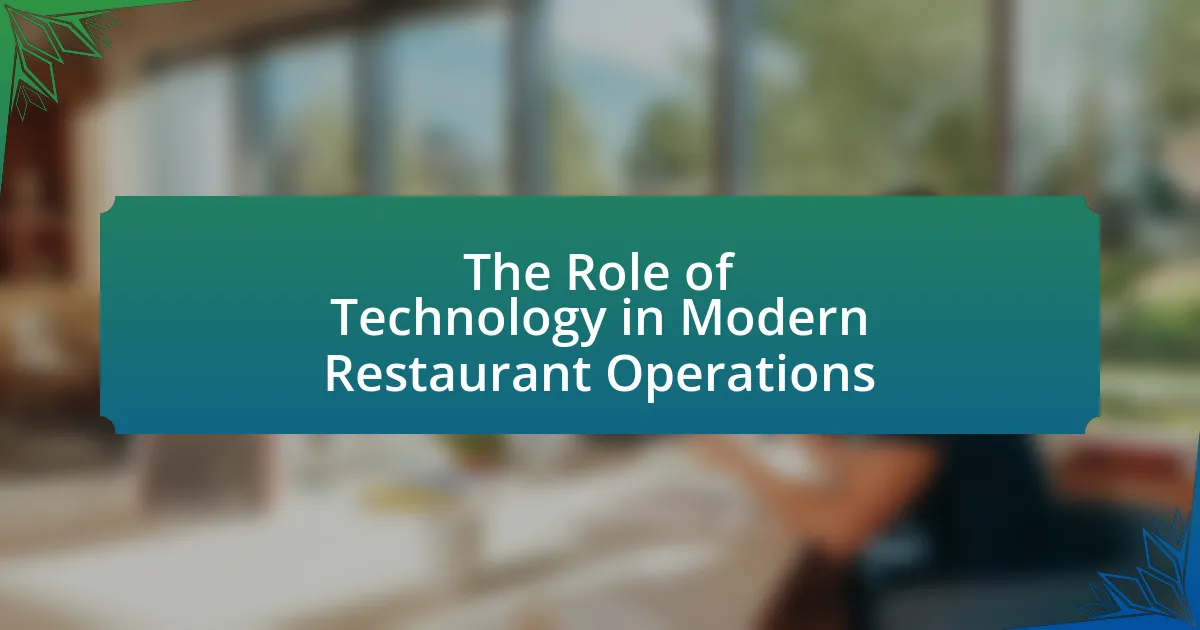Restaurant Workflow Analysis is a systematic approach to examining and optimizing processes within a restaurant to enhance efficiency and customer satisfaction. The article explores the impact of workflow analysis on operational efficiency, highlighting key components such as order management, food preparation, service delivery, and inventory control. It discusses various tools and techniques, including process mapping and data analysis, that can identify bottlenecks and improve service speed. Additionally, the article emphasizes the importance of staff training, technology integration, and continuous review in achieving effective workflow optimization, ultimately leading to increased profitability and enhanced customer experiences.

What is Restaurant Workflow Analysis?
Restaurant Workflow Analysis is the systematic examination of processes and operations within a restaurant to identify inefficiencies and areas for improvement. This analysis involves mapping out tasks, assessing staff roles, and evaluating the flow of food and service from the kitchen to the customer. By utilizing tools such as process mapping and time-motion studies, restaurants can enhance productivity, reduce wait times, and improve overall customer satisfaction. Studies have shown that optimizing workflow can lead to a 20% increase in efficiency, demonstrating the tangible benefits of effective workflow analysis in the restaurant industry.
How does restaurant workflow analysis impact overall efficiency?
Restaurant workflow analysis significantly enhances overall efficiency by identifying bottlenecks and optimizing processes. By systematically examining each step in food preparation, service, and customer interaction, restaurants can streamline operations, reduce wait times, and improve staff productivity. For instance, a study by the National Restaurant Association found that implementing workflow analysis can lead to a 20% increase in service speed and a 15% reduction in operational costs. This data underscores the effectiveness of workflow analysis in driving efficiency improvements in restaurant settings.
What are the key components of restaurant workflow?
The key components of restaurant workflow include order management, food preparation, service delivery, and inventory control. Order management involves taking and processing customer orders efficiently, ensuring accuracy and speed. Food preparation encompasses the cooking and assembly of dishes, adhering to safety and quality standards. Service delivery focuses on the timely and courteous presentation of food to customers, which is crucial for customer satisfaction. Inventory control involves tracking stock levels, managing suppliers, and minimizing waste to maintain profitability. Each component is essential for a seamless operation, contributing to overall efficiency and customer experience in the restaurant industry.
How do these components interact within a restaurant setting?
In a restaurant setting, components such as kitchen staff, front-of-house staff, and technology interact to create an efficient workflow. Kitchen staff prepare meals based on orders received from front-of-house staff, who take customer orders and manage the dining experience. Technology, such as point-of-sale systems, facilitates communication between these two groups by transmitting orders and tracking inventory. This interaction ensures timely service and customer satisfaction, as evidenced by studies showing that efficient communication can reduce order errors by up to 30%.
Why is analyzing restaurant workflow important?
Analyzing restaurant workflow is important because it enhances operational efficiency and improves customer satisfaction. By systematically examining each step in the workflow, restaurants can identify bottlenecks, reduce wait times, and streamline processes. For instance, a study by the National Restaurant Association found that optimizing workflow can lead to a 20% increase in service speed, directly impacting customer experience and revenue. This analysis also aids in resource allocation, ensuring that staff and materials are utilized effectively, which can result in cost savings and higher profit margins.
What benefits does workflow analysis provide to restaurant management?
Workflow analysis provides restaurant management with enhanced operational efficiency, improved staff productivity, and better customer service. By systematically examining processes, management can identify bottlenecks and redundancies, leading to streamlined operations. For instance, a study by the National Restaurant Association found that optimizing workflows can reduce service times by up to 20%, directly impacting customer satisfaction and repeat business. Additionally, workflow analysis enables better resource allocation, ensuring that staff are deployed effectively during peak hours, which can increase overall sales and profitability.
How can workflow analysis improve customer satisfaction?
Workflow analysis can improve customer satisfaction by identifying inefficiencies and streamlining processes within a restaurant. By examining each step of service delivery, restaurants can reduce wait times, enhance food quality, and ensure consistent service. For instance, a study by the National Restaurant Association found that optimizing workflow can lead to a 20% increase in service speed, directly correlating with higher customer satisfaction ratings. This improvement in efficiency allows staff to focus more on customer interactions, leading to a more positive dining experience.

What tools are available for analyzing restaurant workflow?
Tools available for analyzing restaurant workflow include point-of-sale (POS) systems, kitchen display systems (KDS), and restaurant management software. POS systems, such as Square and Toast, provide data on sales trends, customer preferences, and employee performance, enabling managers to identify bottlenecks and optimize service. Kitchen display systems streamline communication between front-of-house and back-of-house, improving order accuracy and speed. Restaurant management software, like 7shifts and HotSchedules, offers insights into staff scheduling, labor costs, and inventory management, allowing for more efficient operations. These tools collectively enhance workflow analysis by providing actionable data that can lead to improved efficiency and customer satisfaction.
How do technology tools enhance workflow analysis?
Technology tools enhance workflow analysis by providing real-time data collection and visualization, which allows for more accurate assessments of operational efficiency. These tools, such as point-of-sale systems and inventory management software, enable restaurants to track performance metrics like order times and inventory turnover. For instance, a study by the National Restaurant Association found that restaurants using technology tools can improve service speed by up to 30%, demonstrating the effectiveness of these tools in optimizing workflows.
What are the most popular software solutions for restaurant workflow analysis?
The most popular software solutions for restaurant workflow analysis include Toast, Square for Restaurants, and 7shifts. Toast provides an all-in-one platform that integrates point-of-sale, inventory management, and employee scheduling, which enhances operational efficiency. Square for Restaurants offers a user-friendly interface and robust reporting features that help streamline operations and improve service quality. 7shifts specializes in employee scheduling and labor management, allowing restaurants to optimize staff allocation and reduce labor costs. These solutions are widely adopted in the industry due to their effectiveness in improving restaurant operations and enhancing overall productivity.
How can mobile applications assist in workflow management?
Mobile applications can assist in workflow management by streamlining communication, task assignment, and real-time data access. These applications enable restaurant staff to coordinate effectively, ensuring that orders are processed efficiently and customer service is optimized. For instance, a study by the National Restaurant Association found that 70% of restaurants using mobile technology reported improved operational efficiency. This efficiency is achieved through features such as instant messaging, task tracking, and inventory management, which collectively enhance productivity and reduce errors in workflow processes.
What traditional methods are still effective in workflow analysis?
Traditional methods that remain effective in workflow analysis include process mapping, time and motion studies, and value stream mapping. Process mapping visually represents the steps in a workflow, allowing for the identification of inefficiencies and bottlenecks. Time and motion studies involve observing and recording the time taken for each task, which helps in optimizing labor and resource allocation. Value stream mapping focuses on analyzing the flow of materials and information, highlighting areas for improvement in efficiency and waste reduction. These methods have been utilized in various industries, including restaurants, to enhance operational efficiency and improve service delivery.
How can manual observation contribute to understanding workflow?
Manual observation significantly enhances the understanding of workflow by providing real-time insights into processes and interactions. This method allows observers to identify inefficiencies, bottlenecks, and areas for improvement that may not be evident through data analysis alone. For instance, a study published in the Journal of Operations Management found that manual observation in restaurant settings led to a 20% increase in service efficiency by pinpointing delays in food preparation and customer service interactions. By directly witnessing the workflow, managers can make informed decisions to optimize operations, ultimately improving overall performance and customer satisfaction.
What role do employee feedback and surveys play in analysis?
Employee feedback and surveys are crucial for analyzing restaurant workflow as they provide direct insights into employee experiences and operational challenges. These tools enable management to identify areas for improvement, enhance employee satisfaction, and optimize processes. For instance, a study by Gallup found that organizations with high employee engagement, driven by feedback mechanisms, experience 21% higher profitability. This correlation underscores the importance of employee input in refining workflows and achieving operational efficiency in the restaurant industry.

What techniques can be used to analyze restaurant workflow?
Techniques to analyze restaurant workflow include process mapping, time-motion studies, and performance metrics analysis. Process mapping visually outlines each step in the workflow, helping identify bottlenecks and inefficiencies. Time-motion studies involve observing and recording the time taken for various tasks, which can reveal areas for improvement. Performance metrics analysis uses key performance indicators (KPIs) such as table turnover rates and order accuracy to assess operational efficiency. These techniques are validated by their widespread use in the restaurant industry, demonstrating their effectiveness in optimizing workflow and enhancing service delivery.
How can process mapping improve workflow understanding?
Process mapping improves workflow understanding by visually representing the steps and interactions within a process, allowing stakeholders to identify inefficiencies and areas for improvement. This visual tool clarifies roles, responsibilities, and the sequence of tasks, making it easier to analyze how work flows through a system. Research indicates that organizations using process mapping can reduce process cycle times by up to 30%, as it highlights bottlenecks and redundancies that may not be apparent in textual descriptions. By providing a clear overview, process mapping enhances communication among team members, leading to more effective collaboration and streamlined operations.
What steps are involved in creating a process map for a restaurant?
Creating a process map for a restaurant involves several key steps: identifying the processes, gathering information, defining the scope, mapping the processes, validating the map, and implementing it.
First, identifying the processes includes determining which workflows, such as order taking, food preparation, and service, need to be mapped. Next, gathering information requires collecting data from staff and observing operations to understand how each process functions. Defining the scope involves deciding the boundaries of the process map, such as whether to include front-of-house, back-of-house, or both.
Mapping the processes entails visually representing the steps in each workflow using standardized symbols and notations, which helps clarify the sequence of activities. Validating the map involves reviewing it with stakeholders to ensure accuracy and completeness. Finally, implementing the process map means using it as a guide for training staff and improving operational efficiency.
These steps are essential for creating an effective process map that enhances workflow understanding and operational performance in a restaurant setting.
How can process mapping identify bottlenecks in workflow?
Process mapping identifies bottlenecks in workflow by visually representing each step in a process, allowing for the analysis of flow and timing. This technique highlights areas where delays occur, such as excessive wait times or resource constraints, by illustrating the sequence and interdependencies of tasks. For instance, a study by the Lean Enterprise Institute found that process mapping can reduce cycle times by up to 30% by pinpointing inefficiencies. By analyzing the mapped processes, stakeholders can implement targeted improvements, thereby enhancing overall efficiency and productivity in restaurant operations.
What role does data analysis play in workflow optimization?
Data analysis plays a crucial role in workflow optimization by identifying inefficiencies and areas for improvement within operational processes. By examining data related to customer orders, staff performance, and inventory levels, restaurant managers can make informed decisions that streamline operations. For instance, a study by the National Restaurant Association found that restaurants utilizing data analytics improved their operational efficiency by up to 20%, leading to reduced wait times and enhanced customer satisfaction. This demonstrates that effective data analysis not only highlights bottlenecks but also facilitates strategic adjustments that enhance overall workflow efficiency.
How can key performance indicators (KPIs) be used in workflow analysis?
Key performance indicators (KPIs) can be used in workflow analysis to measure the efficiency and effectiveness of processes within a restaurant. By tracking specific KPIs such as order fulfillment time, table turnover rate, and customer satisfaction scores, restaurant managers can identify bottlenecks and areas for improvement in their workflows. For instance, a study by the National Restaurant Association highlights that optimizing table turnover can increase revenue by up to 20%. This data-driven approach allows for informed decision-making, ultimately enhancing operational performance and customer experience.
What data sources are most valuable for restaurant workflow analysis?
The most valuable data sources for restaurant workflow analysis include point-of-sale (POS) systems, employee scheduling software, inventory management systems, and customer feedback platforms. POS systems provide detailed sales data, allowing restaurants to analyze peak hours and popular menu items, which aids in staffing and inventory decisions. Employee scheduling software tracks labor hours and productivity, helping to optimize workforce management. Inventory management systems offer insights into stock levels and usage patterns, enabling better purchasing decisions. Customer feedback platforms gather insights on service quality and menu preferences, informing operational improvements. Collectively, these data sources enable restaurants to enhance efficiency, reduce costs, and improve customer satisfaction.
What are best practices for implementing workflow analysis in restaurants?
Best practices for implementing workflow analysis in restaurants include mapping out current processes, engaging staff in the analysis, utilizing technology for data collection, and continuously reviewing and refining workflows. Mapping processes allows for a clear visualization of operations, which helps identify bottlenecks and inefficiencies. Engaging staff ensures that insights from those directly involved in the workflow are considered, leading to more effective solutions. Utilizing technology, such as point-of-sale systems and inventory management software, aids in collecting accurate data on performance metrics. Continuous review and refinement of workflows based on collected data and staff feedback ensure that the restaurant adapts to changing demands and improves efficiency over time. These practices are supported by studies indicating that restaurants that regularly analyze and optimize their workflows can increase operational efficiency by up to 30%.
How can staff training enhance the effectiveness of workflow analysis?
Staff training enhances the effectiveness of workflow analysis by equipping employees with the necessary skills and knowledge to identify inefficiencies and improve processes. Trained staff can accurately assess their roles within the workflow, leading to more precise data collection and analysis. For instance, a study by the American Society for Training and Development found that organizations with comprehensive training programs experience a 218% higher income per employee than those without. This correlation indicates that well-trained staff contribute to more effective workflow analysis by providing insights that drive operational improvements.
What common pitfalls should be avoided during workflow analysis?
Common pitfalls to avoid during workflow analysis include failing to involve key stakeholders, neglecting to document existing processes, and overlooking data collection. Involving key stakeholders ensures that the analysis reflects the perspectives and needs of those directly impacted by the workflow, which is crucial for accurate assessment and improvement. Neglecting to document existing processes can lead to misunderstandings and misrepresentations of how tasks are currently performed, hindering effective analysis. Overlooking data collection limits the ability to make informed decisions based on actual performance metrics, which are essential for identifying bottlenecks and inefficiencies. These pitfalls can significantly undermine the effectiveness of workflow analysis in a restaurant setting.
What practical tips can improve restaurant workflow analysis?
To improve restaurant workflow analysis, implement systematic data collection and analysis methods. Utilizing point-of-sale (POS) systems can provide real-time sales data, helping identify peak hours and customer preferences. Additionally, conducting time-motion studies can reveal inefficiencies in staff movements and task completion, allowing for targeted improvements. Research indicates that restaurants that analyze workflow can increase efficiency by up to 20%, as evidenced by a study from the National Restaurant Association, which highlights the importance of data-driven decision-making in optimizing operations.




